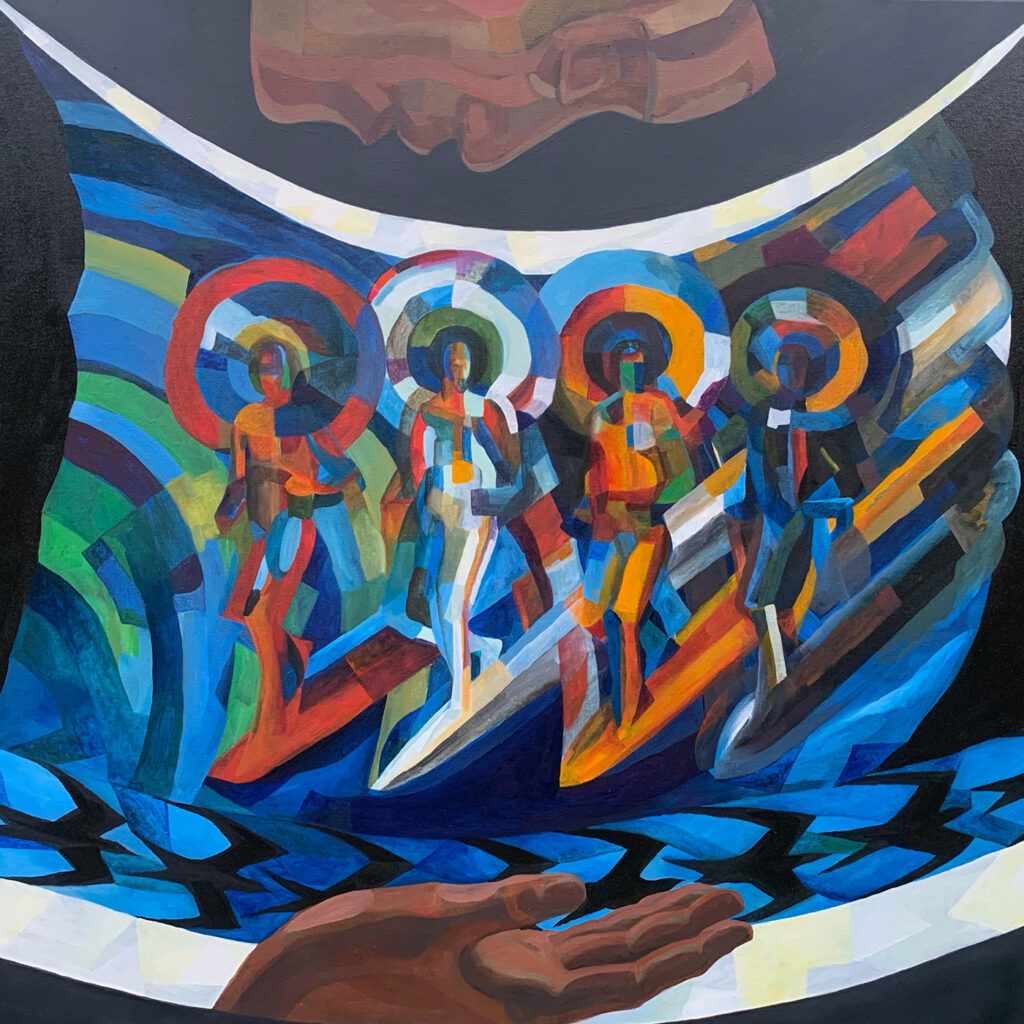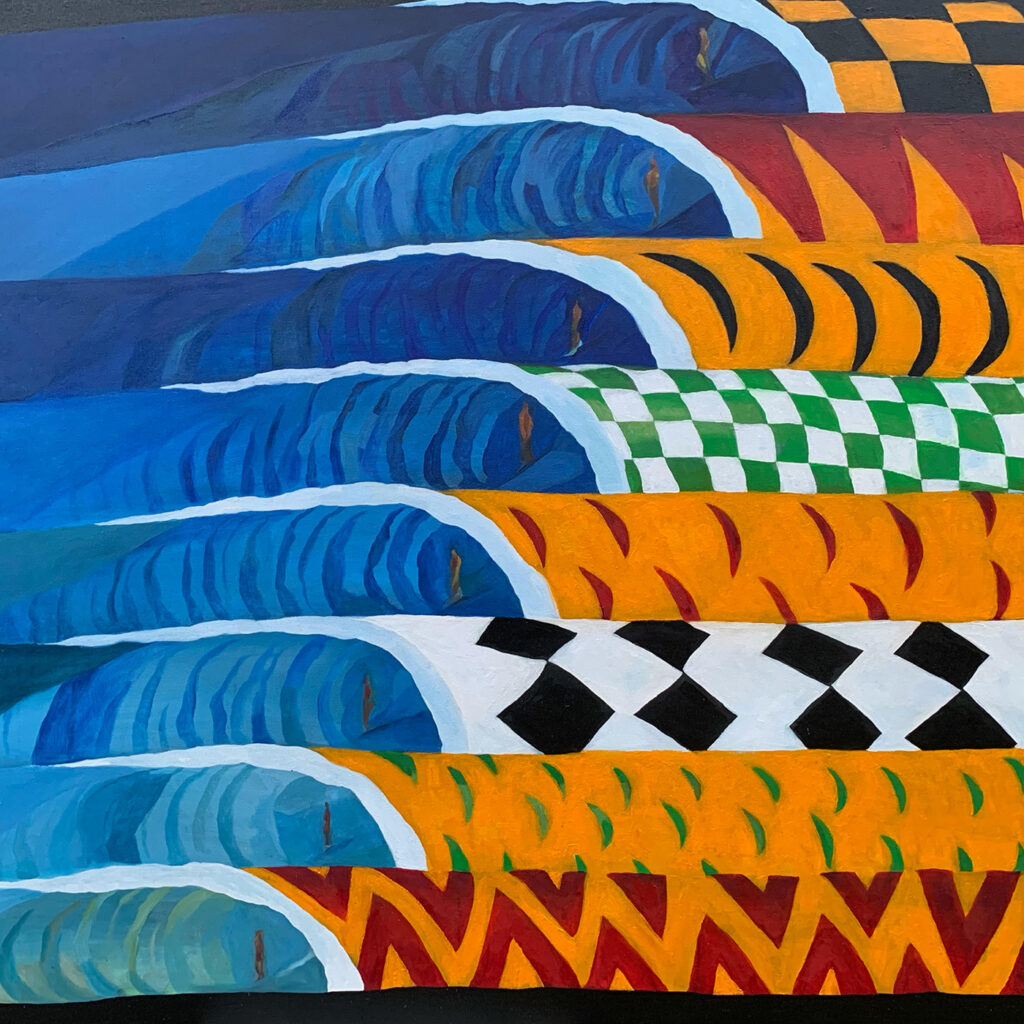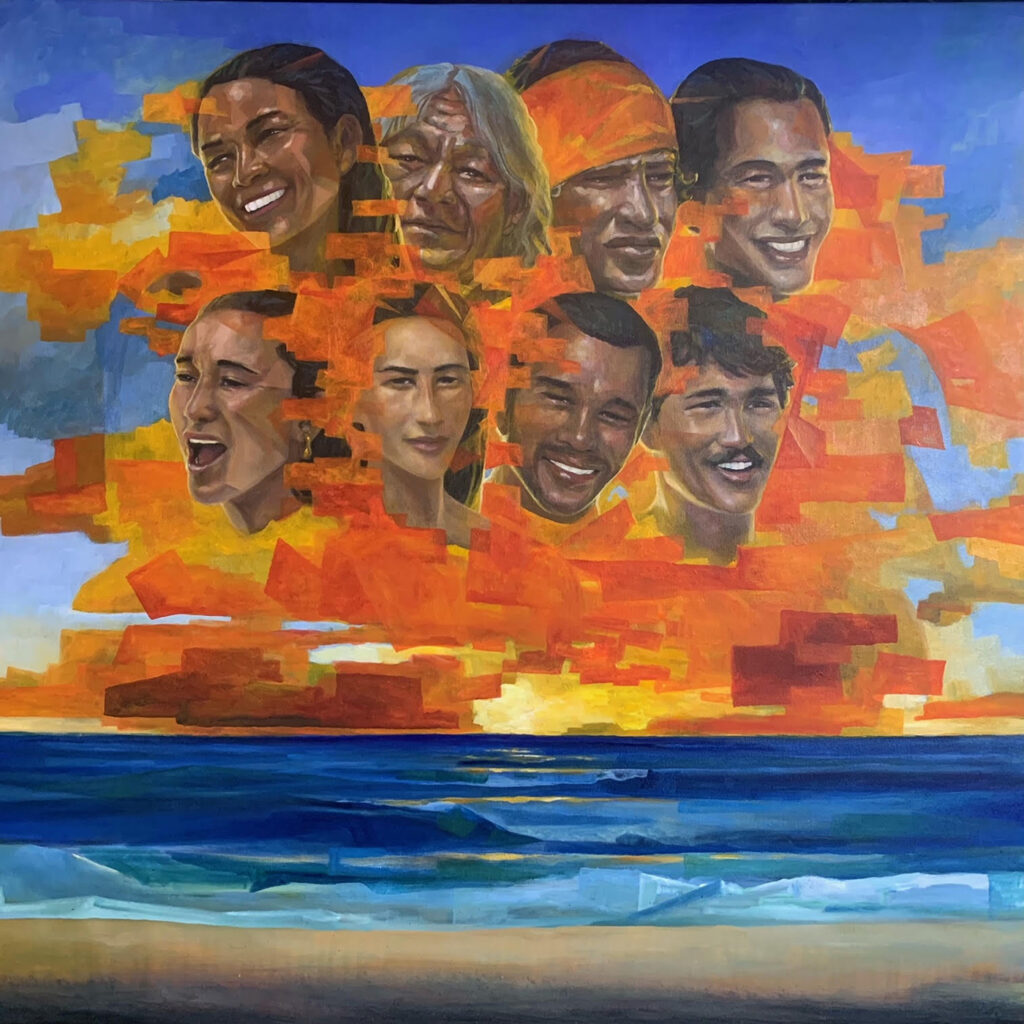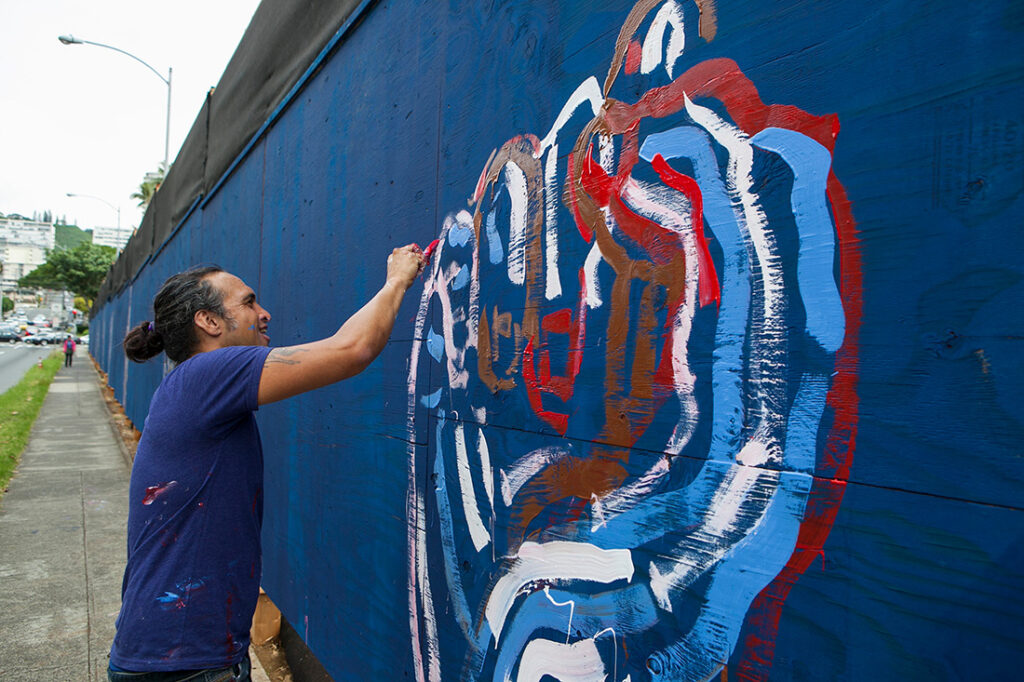
Commissioned by Vans
Curated by Nā Kama Kai
“When I’m painting I’m doing protocol: I’m practicing my oli. So as I’m working Iʻm practicing my oli. I feel like the kapu is lifted in time and then when I pau I close them again afterwards with oli.”
– Solomon Enos, Artist
Introduction
It is important to understand the genealogy of surfing. Every time you paddle out, you’re experiencing something from a culture that should inspire you to have grace in the water. You are not surfing to be intentionally aggressive; not to be out there fighting; or angry or trying to take every wave, but to be out there and be connected to the ‘āina, which is the kai.
Let the flow happen on the wave.
Revisit your narrative of where surfing comes from, and why the narrative coming from Hawai‘i represents values like pono, ‘ohana and ‘āina.
Transform your mantra to: “I enjoy surfing because of the mo‘olelo of Hawai‘i – I am here to serve and have that happiness that surfing is supposed to bring me.”
“Each of these five panels are almost like a story – they are sequential.”
– Solomon Enos
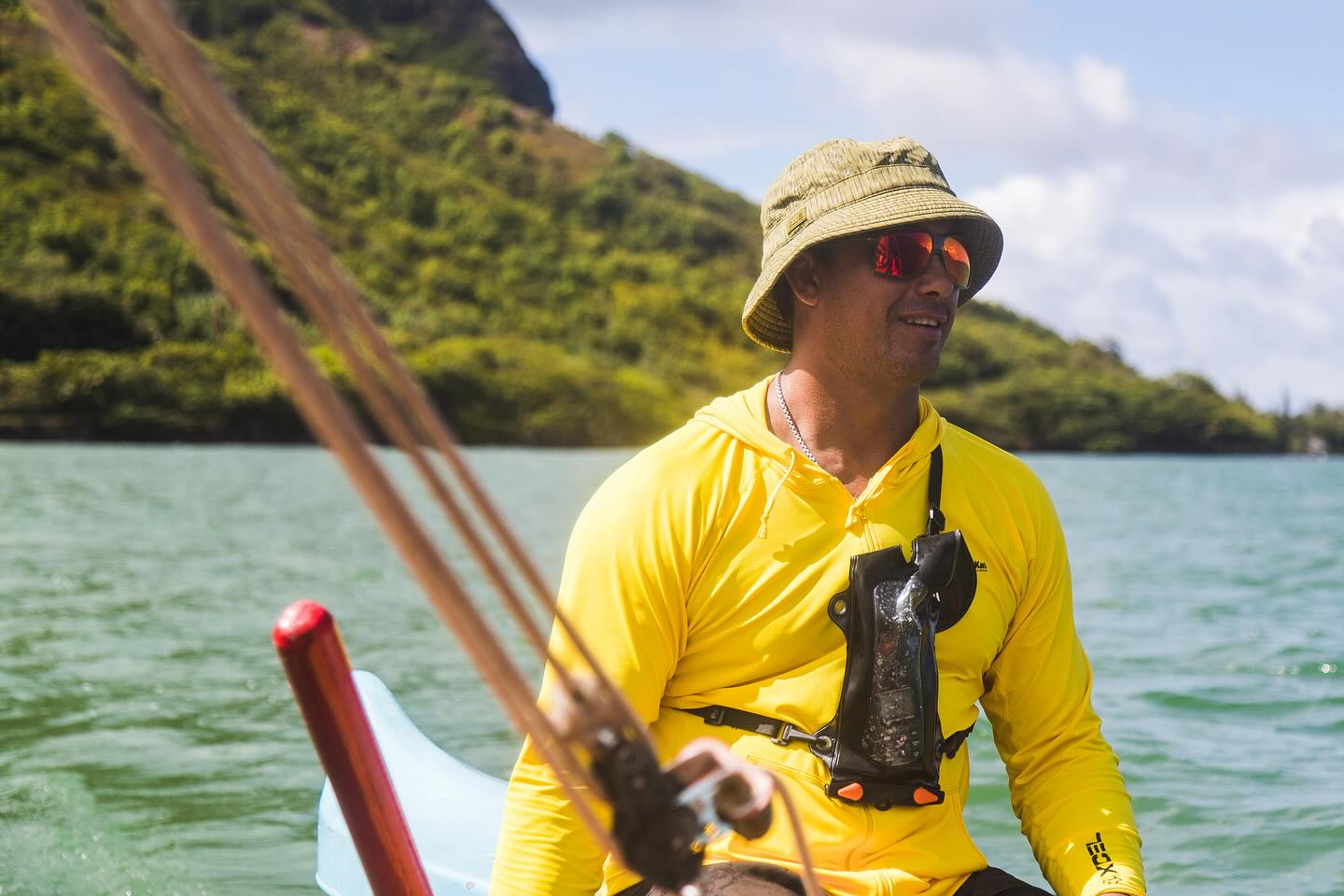
“I really try my best to always draw back to Mākaha – people from Mākaha. Whether they’re Hawaiian, or from Wai‘anae, I want to go back to our sources because we have so much talent from within. And with Solomon, I’ve seen his artwork all over Hawai‘i. His artwork is a way of telling the truth in a form of take it or leave it, but this is the truth. This is what the Hawaiian people felt. This is what was happening to the ‘āina. Solomon draws connections through his artwork to all the things that are pono in our daily life.”
– Duane DeSoto, Nā Kama Kai Founder & CEO
PANEL 1: AKUA
Depicted here are Papa, Papahānaumokuakea, Haumea and Hina. Papahānaumokuākea is the union of two Hawaiian ancestors – Papahānaumoku and Wākea – who gave rise to the Hawaiian Archipelago, the taro plant, and the Hawaiian people. Papa represents the islands, and her hand (lima) is the foundation. Elevating above is the iwa bird.
With many different forms, smells, and kinolau, this oil painting illustrates the four akua: Kū, Lono, Kāne, and Kanaloa. They are synonymous with war and forests, peace and agriculture, light and fresh water, and the ocean and underworld.
Yellow is a reoccurring color through each image as we are all descendants of Kāne. There are also white strips going above and below to represent the mahina. This is a wāhine story.
PANEL 2: ‘ĀINA
Our ancestors understood that the deepest connection with the gods, with divinity, with the most powerful source of mana comes from darkness. Hina is the background as the moon, Kanaloa is represented in black as darkness, and each curve represents the 1,000 lines of the Kumulipo. What’s important in this painting is the ānuenue because it’s coming from the time of the gods who would leap from island to island on rainbows. Every ānuenue belongs to everybody, yet it is an individual experience. So, when we think about our connection with ‘āina, with every fabric of reality, everybody has their own rainbow. To me, it’s an example of augmented reality, like nature already showing us forms of augmented reality.
PANEL 3: ALI‘I
In this painting, one thing I really wanted to touch on is that we (Hawaiians) were able to attain a degree of pono. As Kumu John Osorio says, pono is profound equilibrium. When you’re quiet and humble, you can feel our ancestors. And when you listen, you can hear unbelievable truths. You can tune in to the frequency that your kūpuna are having conversations on.
The surfboard represents the point where humans and nature are unified. To interface with the wave, Hawaiians had to be able to attain a kind of stance. This is why Hawaiians are the origins of balance. The more in balance you are, the better you’re going to ride all the waves in life. To be as pili with the wave as possible, it’s my hypothesis that ali‘i would not wear their malo, ahu‘ula, mahi‘ole, or anything. They are naked. The only thing they are wearing is the board.
Red is the color of the priests, so priests utilized red to represent Akua. Yellow is the color of the chiefs, and it represents ‘āina. This is why red and yellow is very much associated with ali‘i colors.
PANEL 4: THE MONARCHY
Moving from abstraction into representationalism, the fourth panel depicts four monarchs who have a history in surfing: Kamehameha the Great, Queen Ka‘ahumanu, Prince Kūhiō, and Princess Ka‘iulani.
All of their maka, all of their eyes, are lined up – in this way as a continuum. It is through the maka, that we have this mo‘o continuity of mo‘okū‘auhau (your genealogy), mo‘olelo (your story), and mo‘opuna (grandchildren).
On the far left, we have the pō (darkness) representing everyone that we could not possibly represent. Kamehameha represents a changing of the tide. The Union Jack forms the upper part of the wave and the long-standing connection that we have with England.
That is why the world needs the story of our monarchy, just like our papa he‘enalu. The world needs to remember how to love and mālama people because it’s rooted in our monarchy.
PANEL 5: ME‘E
Surfing hero: Rell Sunn, Buffalo Keaulana, Eddie Aikau, Duke Kahanamoku, Carissa Moore, Honolua Blomfield, Sunny Garcia, and Derek Ho.
At the bottom there is darkness as the foundation. Like the ānuenue panel, we see not just one sunset, but 100 or 1,000 sunsets. As we move into the future, the melemele of Kāne continues and the colors are becoming superimposed and becoming part of the cloud. This painting in on the edge of those who are kūpuna and those who are ‘aumakua. Our ancestors had a completely different understanding of what it means to be alive and not alive. In a Western sense, it’s very binary, but in a Hawaiian sense, it’s a lot more fluid.
I think that’s another wonderful gift we could give the world to say, “no build your cultures and try run away from death like trying to run away from darkness.” Darkness, death, there is nothing more natural. Love every sunset, every wave, every grain of sand.

THE ARTIST: SOLOMON ENOS
Solomon Enos is a Native Hawaiian artist, illustrator, and visionary. Born and raised in Mākaha Valley, Solomon hails from the well-known Enos ‘ohana. Solomon is proud of his family, and credits them for much of his original inspiration and support in becoming an artist. Solomon has been making art for more than 30 years and he is adept at artistic expression in a wide variety of media including oil paintings, book illustrations, murals, and game design.
A self-described “Possibilist” Solomon’s art expresses an informed aspirational vision of the world at its best via contemporary and traditional art that leans towards Sci-Fi and Fantasy. His work touches on themes like collective-consciousness, ancestry and identity, our relationship with our planet, and all through the lens of his experience as a person indigenous to Hawai‘i.
Solomon has exhibited in Biennial X (Honolulu Museum of Art), 6th Asia Pacific Triennial of Contemporary Art (Queensland Art Gallery), CONTACT art exhibitions, and others. His work is held in private collections and in the public collections of the Smithsonian Asian Pacific American Center and Hawai’i State Art Museum. He has led numerous community mural projects and has received art commissions for hotels, corporate offices, public buildings, and schools in Hawai‘i. His latest works include murals and augmented-reality installations for Google and Disney.
Join the Nā Kama Kai Hui
- Monthly Newsletter including recent highlights and notifications of Nā Kama Kai’s special events and activities
- Knowledge that you are advocating Nā Kama Kai’s efforts in connecting our keiki with the kai (ocean) and nurturing a deep sense of aloha and kuleana

